Introduction: The unexploded cluster ordnances used by the Syrian regular forces and their allies mainly during the years of the Syrian conflict form a grave and fatal threat on the lives of many Syrian children. Many children victims who survived the explosion of those munitions still suffer up to now the wounds they have got being permanent disabilities or deformities that changed their lives and made them different from other children.
In Aleppo countryside that is held by anti-government groups, unexploded cluster munitions have claimed lives of scores of children and changed lives of many. Several parents have lost their children, while others still struggle to treat them today.
According to Syrians for Truth and Justice/STJ’s field researcher, the Syrian regular forces and their allies earlier 2018 and 2017, had used cluster munition missiles to bombard areas held by Syrian armed opposition factions in Aleppo countryside. They attacked residential complexes in the towns of (Orem Al-Kobra, Atarib, Sheikh Ali, Khan al-Asal, Kafr Naha, Kafrnaseh, and Injarara) with cluster ammunition. The attacks killed and injured many civilians as soon as they occurred, while many unexploded cluster munitions became ticking time bombs to explode as soon as they are touched or moved; besides they have turned into an obsession that terrify and worry many civilians in Aleppo countryside.
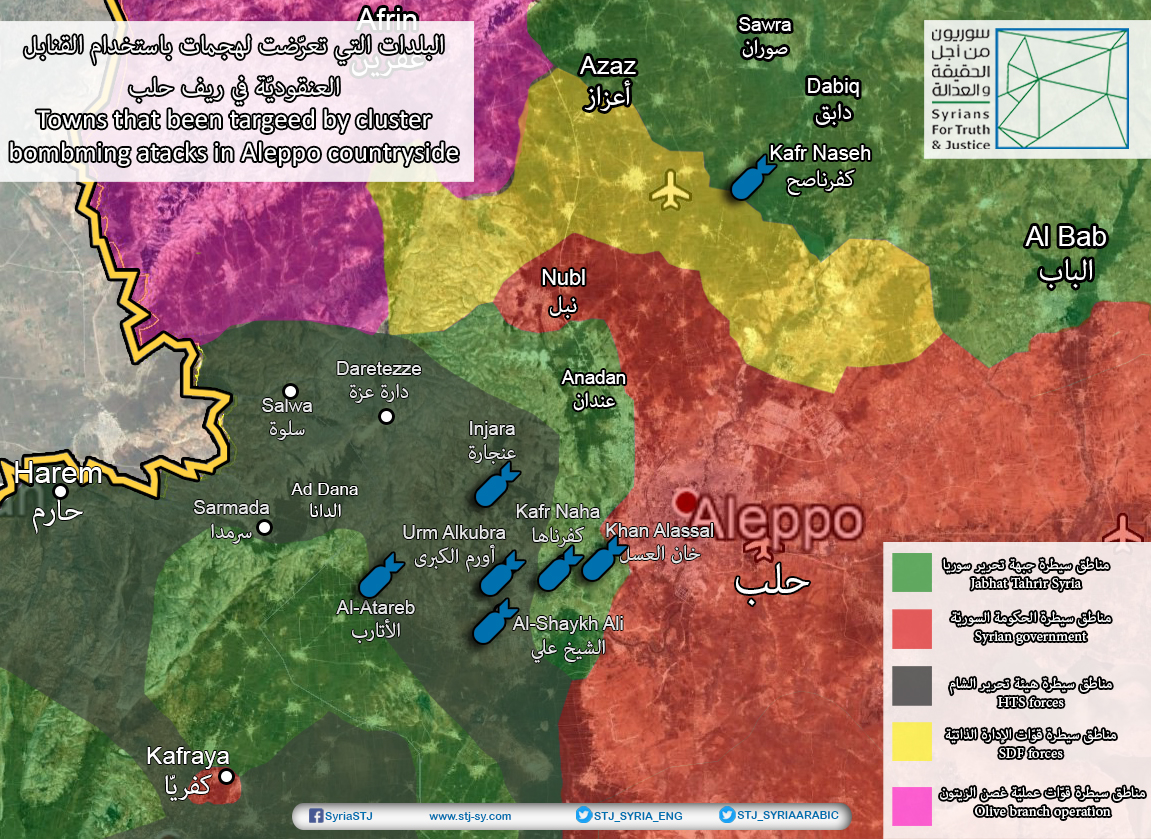
A map illustrates the towns’ location in Aleppo countryside (Orem Al-Kobra, Atarib, Sheikh Ali, Khan al-Asal, Kafr Naha, Kafrnaseh, and Injarara).
STJ had earlier prepared A Special Report Tells Accounts of Some Victims of Incendiary Weapons and the Effects of These Substances by Using Them as Weapon in Syria. STJ also documented the use of cluster munitions by Syrian regular forces and their allies in 2017 And 2018, the most recent was in February 2018, where Attacks with Cluster Munitions Target Eastern Ghouta Towns and Cities.
Cluster Munitions and the Syrian Armed Conflict
“Cluster munitions are weapons consisting of a container that opens in the air and scatters large numbers of bomblets or explosive submunitions over a wide area. Depending on the model, the number of submunitions can vary from several dozen to more than 600. Cluster munitions can be delivered by aircraft, artillery or missiles.
Most submunitions are intended to explode on impact. The vast majority are free-falling, meaning they are not individually guided towards a target.
Cluster munitions were first used in World War II and a large proportion of currently stockpiled cluster munitions were designed for context of the Cold War. The main purpose was to destroy multiple military targets dispersed over a wide area, such as tank or infantry formations, and to kill or injure combatants[1].”
“The majority of cluster munitions do not explode as intended but remain a threat to life until they are moved. It is more dangerous for civilians because of the vast area (known as "suspicious spots") that cluster bombs from a single munition can cover.[2]”
“118 states prohibit the use of cluster munitions because of the damage they cause during the attack, but neither the Syrian nor the Russian governments acceded to the Convention on Cluster Munitions, which comprehensively bans the use, production, stockpiling or transferring cluster munitions. It also prohibits States parties from assisting, encouraging or urging any person to engage in any prohibited activity under the Convention.
“Cluster munitions are inherently indiscriminate weapons; therefore, they should be prohibited in any circumstances. Each cluster bomb spreads dozens of small grenades over a larger area than a soccer field. Given the high rates of failing to explode, they pose a threat to the lives of civilians for next years. The repeated use of unguided bombs near the densely populated civilian areas would constitute violating the rule of prohibition of indiscriminate attacks[3].”
First: A Single Cluster Munition Capable of Killing Four Children
On February 1, 2018, one cluster munition harvested the life of four children all at once in the town of Huta located in Aleppo western countryside, including the two brothers (Mahmud Younis Omar, 7, and Ahmed Younis Omar, 4). Their father mourned the death of his two children at the same time, although he is a volunteer in the Civil Defense and has always struggled to keep civilians, especially children, away from the danger of exploding such munitions. In this regard, Younis Omar, the children’s father, told STJ:
"About a year and a half ago, my family and I displaced from Meremin town located in the northern countryside of Aleppo due to violent bombardments, and headed to Huta town located in the western countryside of Aleppo. At approximately 11:00 am, on February 1, 2018, while I was out for some house stuff, my wife told me that she heard sound of a very powerful explosion near the house; when I rushed home, I found my both children Mahmoud and Ahmed lying on the ground with their blood filling the place. Two other children from the neighborhood were accompanying them; they were identified as Mohammed and Amal Haji. My two children died at the spot after the explosion; it was one of the harshest scenes stuck in my head, and, despite the calamity, we tried to aid the rest of the children Mohammed and Amal to the hospital, but Mohammed died only an hour after arriving at a nearby hospital. Amal’s injury was very serious, so she was transferred to a hospital in Turkey, but as a result of her wounds in the upper part of her body, specifically in the head, face and hands, the doctors decided to amputate one of her hands and conduct a surgical operation to extract the cluster bomb fragments from her head. Unluckily, all that was unable to keep her survive, and she died on February8, 2018."
Omar said that the area where the explosion occurred was a populated area with residents and displaced, noting that earlier in 2017, this area had been subjected to attacks several times with rockets loaded with cluster munitions. He indicated that he had removed a large number of such unexploded ordnance with the help of some neighbors, and he warned people of them. He added:
"Being working for the Civil Defense, I am supposed to save the lives of civilians, but I could do nothing to my children nor the neighbors’. I was helpless in front of what happened; one cluster munition was capable of killing four children all at once. He indicated that some of those munitions dropped from warplanes are in the form of toys to draw children's attention."
An image of the two brothers (Ahmed and Mahmoud Younis Omar), just before their death due to an explosion of cluster munition in Aleppo countryside on February 1, 2018.
Photo credit: The two children's family
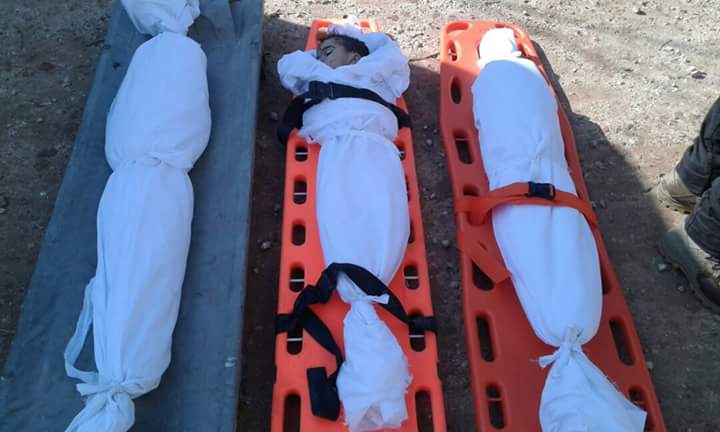
An image showing the burial ceremony of the children (Ahmed, Mahmoud Younis Omar and the child Mohammed Haji), following their death by a cluster munition on February 1, 2018.
Photo credit: The family of both the children Ahmed and Mahmoud Younis Omar.
Image of the child Amal Hajji prior to her death on February 8, 2018.
Photo credit: Family of the child Amal al-Hajji.
An image shows the child Amal while being treated in a Turkish hospital, just before her death on February 8, 2018. Photo credit: Family of the child Amal al-Hajji.
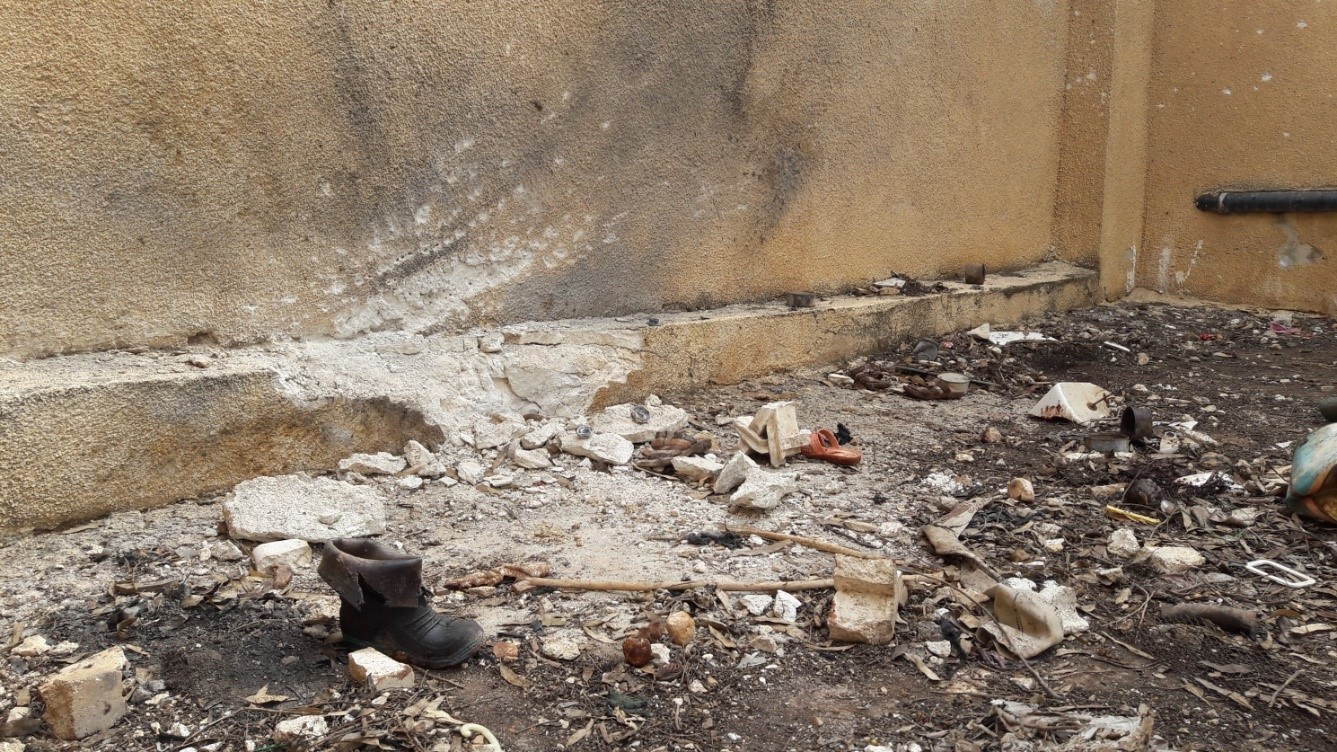
The location of the explosion of a cluster munition that killed four children all at once in Huta town located in the western countryside of Aleppo, taken on February 10, 2018.
Photo credit: STJ
Second: He Lost His Life In Front Of My Eyes, I was Helpless
On December 20, 2017, Ismail al-Mohammed lost his child identified as Imad, who was only 8 years old, due to the explosion of a cluster ammunition near their home located in Khan el-Asal in the western countryside of Aleppo. His tragedy has doubled when he saw his son dying in front of his eyes without being able to do anything. In this regard, he spoke to STJ and said:
"On December 10, 2017, I displaced along with my children from Jabal al-Hass villages in the southern countryside of Aleppo to the town of Khan al-Asal given the violent bombardment campaign that we were exposed to. Only ten days after our departure, my son Imad accompanied my nephew Mohammed to buy some stuff from the next shop, a few minutes later; we heard the sound of a very powerful explosion. We hurried out, the outer wall of our house had traces of blood; my son Imad and my nephew Mohammad had suffered serious injuries as a result of the explosion of a cluster munition. Immediately we dispatched them to nearby hospitals in the area, but we failed given they died in front of my eyes and I stood helpless unable to do anything. Their view would remain in my memory as long as I live. Several days after the incident, through watching and researching the area, we found dozens of unexploded cluster munitions, all thrown by the Syrian/Russian warplanes. No matter how the Civil Defense team attempt to search for and remove these munitions, many will remain, consequently, numbers of victims will continue to increase."

Image of the child Imad Ismail al-Mohammed before his death in the explosion of a cluster munition in Khan al-Asal on December20, 2017.
Photo credit: Family of the child Imad al-Mohammed.
An image showing the child Mohammed al-Mohammed prior to his death on December 20, 2017. Photo credit: Family of the child Mohammed al-Mohammed.
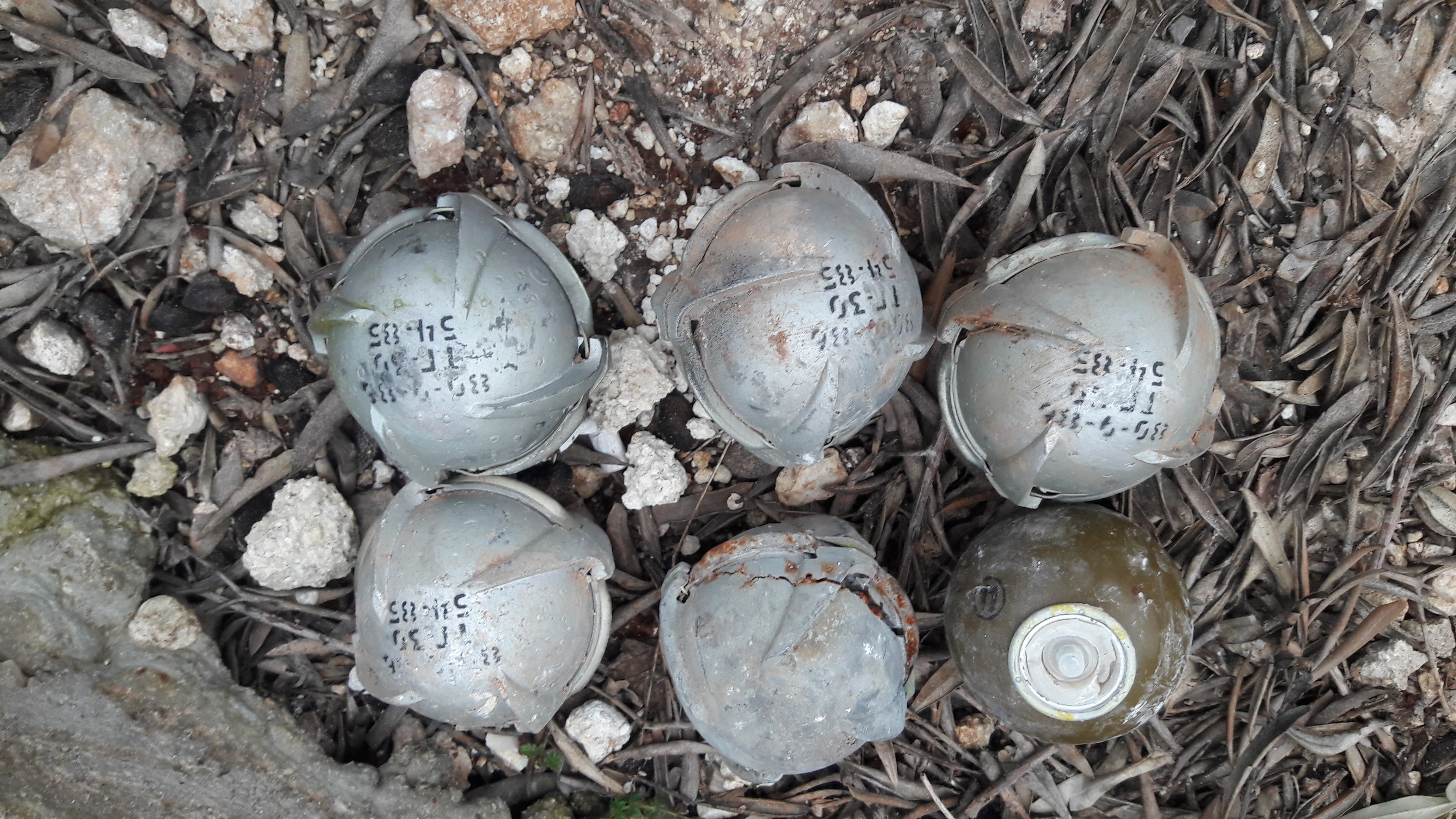
An image showing some of the cluster munitions found by the Civil Defense in Khan al-Asal on February 3, 2018. Photo credit: STJ
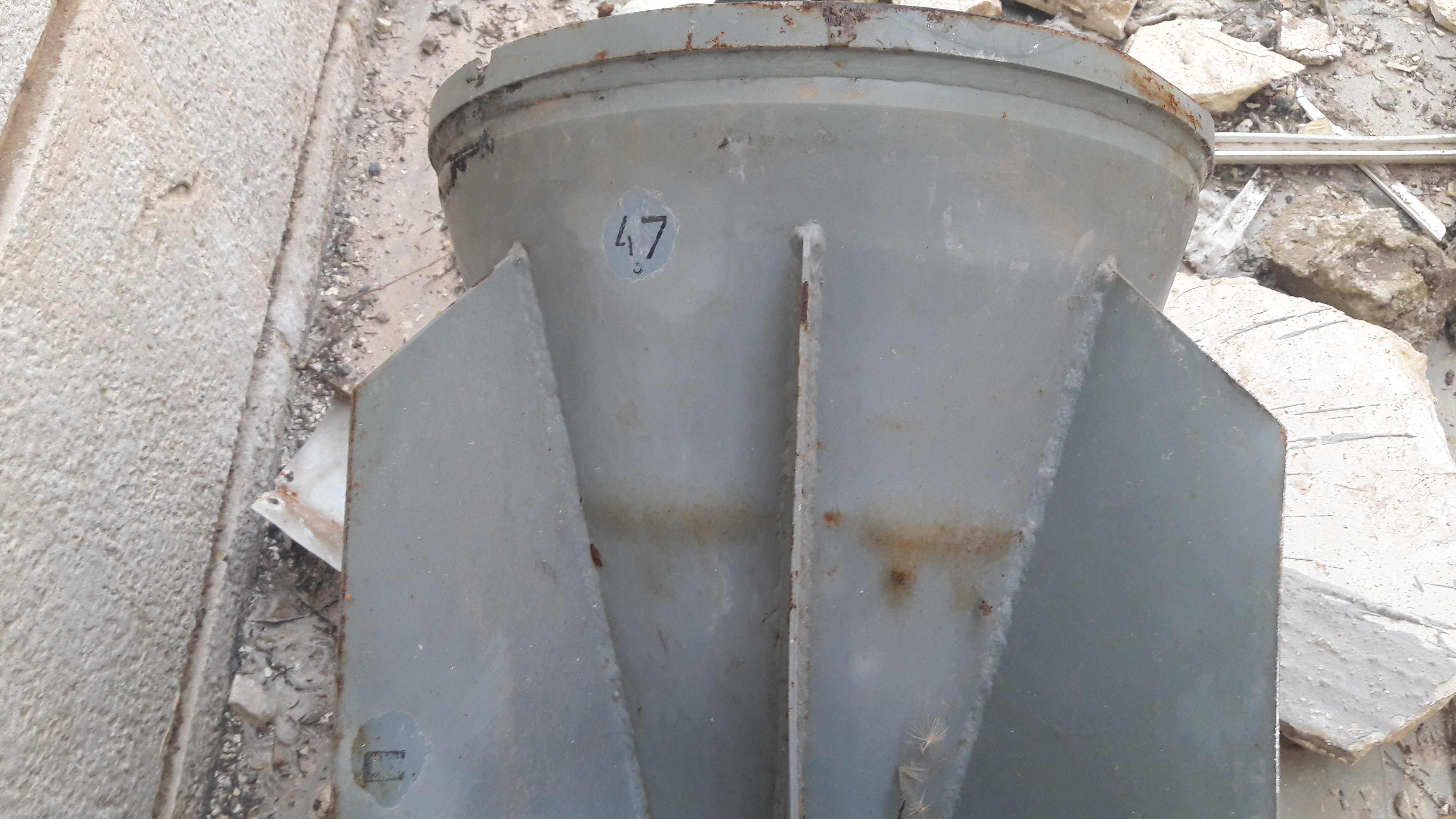
Image shows remnants of a rocket loaded with cluster munitions that fell on Khan al-Asal in February 2018. Photo credit: STJ
Third: She Can No Longer Live Like Other Children
Snds Mohammed al-Ali, 12, was one of the children whose lives had been turned upside down, following a serious injury caused by an explosion of a cluster munition in the garden of her house located in Sheikh Ali town in the western countryside Aleppo, on June 19, 2016. According to her father, warplanes affiliated to the Syrian regular forces had targeted civilian houses in the town by a rocket loaded with cluster munitions, just two days prior to his daughter’s accident. In this connection, he continued:
"While Snds, my daughter, was playing in the garden, one of these cluster bombs exploded, and caused critical injuries to her face and eyes. She was transported to the Turkish hospitals in order to extract the fragments from her eyes, and put metal plates in her cheek. Snds no longer went to school because of the deformities, let alone the series of surgical operations she underwent through a whole year; they have been six operations so far. Those were such a rough days to all of us, especially when we learned that she was going to lose one of her eyes because of the shrapnel. The sight in the other eye remained very weak, apart from shrapnel in one of her feet, which also caused her some kind of disability in walking. We are still trying to cure her by all ways; she is currently in a Turkish hospital. All that I wish is that my daughter stay alive, given the doctors recently told me that her health status is not okay that she is susceptible to meningitis at any time because of the many infections she had lately suffered. What saddens most is that she can no longer be like other children and will never lead a normal life."
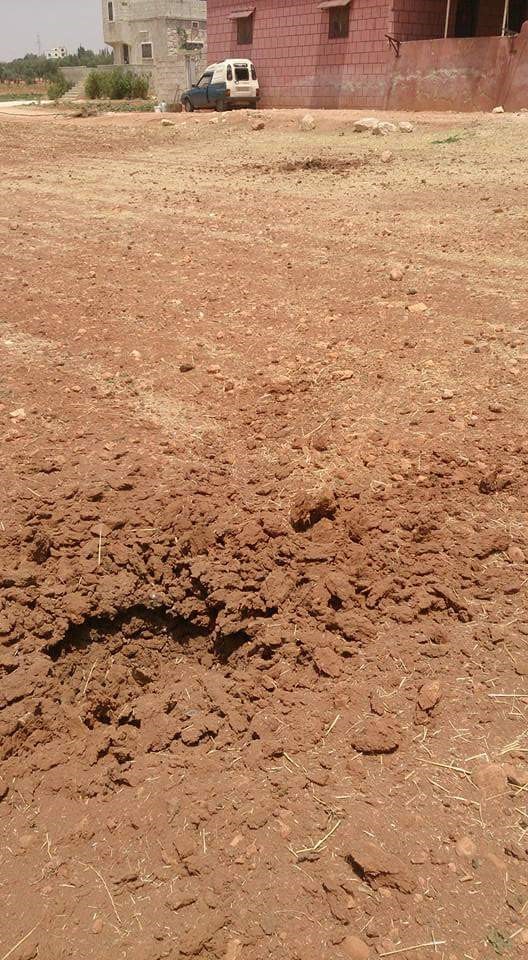
Image shows location of the explosion of a cluster munition near the child's house in Sheikh Ali in the western countryside of Aleppo, taken on June 19, 2016.
Photo credit: Activists from the town.

An image of a cluster munition in Sheikh Ali town located in the western countryside of Aleppo, taken on June 14, 2016.
Photo credit: Activists from the town.
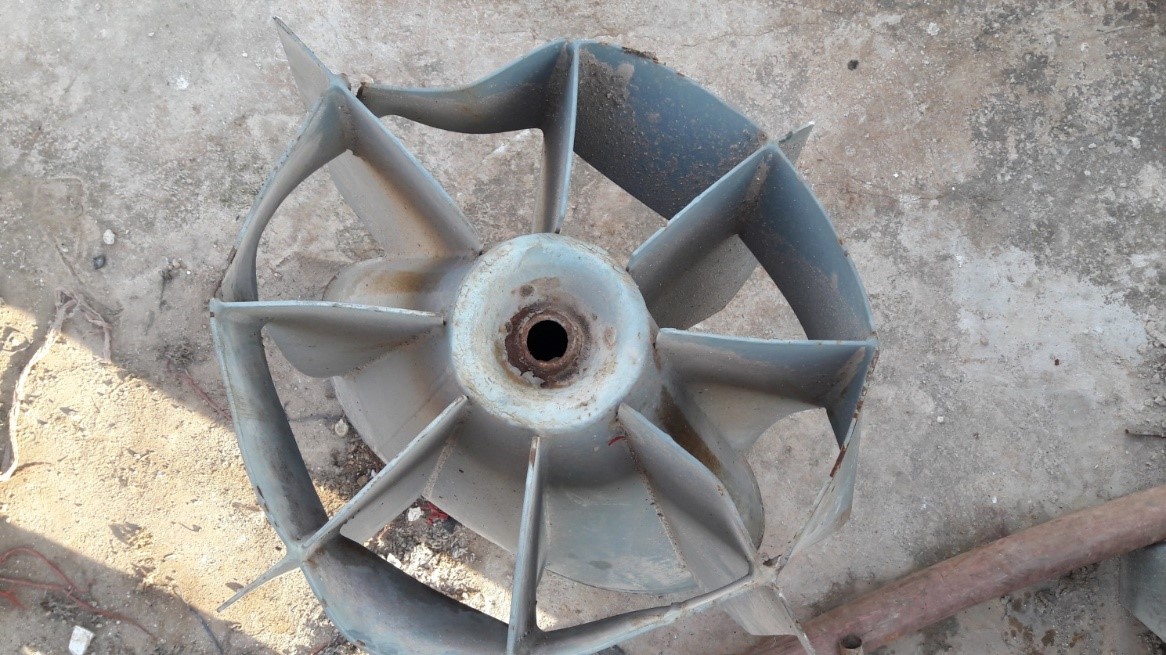
An image shows the remnants of a rocket loaded with cluster munitions that had fallen on Sheikh Ali town in the western countryside of Aleppo earlier in 2017, taken on February 3, 2018.
Photo credit: STJ
Fourth: A Cluster Munition Changes the Lives of Three Children
On November 22, 2016, a cluster munition exploded in the town of Tadil in the western countryside of Aleppo, injuring three brothers identified as Najwa Darwish 13 years old, Abdullatif Darwish 12 years old, and Mohammed Darwish 11 years old. A warplane believed to be Russian had dropped three rockets loaded with cluster munitions on the town just one week before the incident, Rami Darwish, father of the Children confirmed to STJ. In this regard, he added:
"While my children were on their way back from school, they found one of the cluster bombs, and kicked it with their legs, thinking it was a toy, so it exploded causing them critical and horrible injuries, especially in their legs. They were dispatched to a medical point in the town where I work as a radiographer. I was shocked when I saw my son's feet, Mohammed’s feet, the youngest son; it was completely crushed, shrapnel of that bomb pierced his legs dreadfully from the knee area to the toes. Whereas my daughter, Najwa, had also been injured in her feet, as well as some shrapnel in the chest, but my son, Abdullatif had had a mild injury."
Darwish said the doctors had reassured him about Abdullatif’s stable health condition, healed Najwa's wounds, and extracted some fragments from her feet. She had stayed in the hospital for five months in order to set up an external sheet of metal to stabilize her two feet. However, the doctors were unable to remove one of the metal fragments from Najwa's chest; it has not been extracted until now. He added:
"Najwa recovered but she lost control of her toes due to the great damage to the nerves, consequently, she had a great handicap in walking, so, we made her medical shoes that cost SYP 130,000. Najwa still needs surgical operation to extract the metal fragment from her chest. Concerning my child Mohammed, the doctors decided to amputate his two feet because of the lack of therapeutic ratio due to the many wounds and the smashed bones in his feet. I did not agree to amputate Mohammed's feet, and asked to transfer him to a Turkish hospital in Antakya, where the doctors said that amputation of his feet was a wrong decision. Therefore, they conducted several surgeries to renovate Mohammed's feet, but five months later, a negative situation in his health condition come up, and he entered a coma and hallucinations. This made me lose my mind and I collapsed completely, so that I wish he had died immediately after the injury and not see him in such a situation."
Mohammed who was still 11 was transferred to a specialized hospital in the Turkish city of Kilis, the symptoms showed that some fragments remained in his feet. After that, the fragments were extracted and Mohammed stayed in the hospital several months later, according to his father, who added :
"I stayed with Mohammed about nine months in the Turkish hospitals, and I cannot describe nor express the difficulty of that period. Mohammed underwent nine surgeries and doctors say he still needs to perform another surgical operation in the joint when he is 18. The most important is that Mohammed suffered too much. As for me, I lost my job because I could not go to work so long and I stayed with Muhammad, in addition, I received no assistance from anyone, all were at my own expense."
Image of the child (Mohammed Darwish) while receiving treatment in a Turkish hospital.
Photo credit: Family of the child Mohammed Darwish.
Image of the child (Najwa Darwish) while receiving treatment at a hospital.
Photo credit: Family of the child Najwa Darwish.
Fifth: Doha Is No Longer the Same as Before
Doha Juayeed, 11 years old, was another victim of explosion of cluster munitions in Aleppo countryside. On July 10, 2013, while she was only seven years old, she was on the way back from her school located in Zerba town, in the southern countryside of Aleppo, the child tumbled into one of the metal pieces and decided to take it home, unknowing the danger of it and that it might change her life, her father said to STJ. He added:
"Doha was in the first grade; one day her mother saw a metal piece in her hand, immediately she took away that piece metal and put it on top of the house, but Doha messed with that strange body again, and this led to it to explode. Consequently, Doha was injured critically in one of her feet. Later, we discovered that this metal object was but a landmine. Doha was taken to a nearby hospital where they had to heal her wounds, and perform an operation for her infected foot. Despite that, her toes were badly distorted, and the nerve was damaged, thus she became unable to move them at all. Doha was deprived a whole year from school because of the continuation of the treatment that cost up to 900 thousand Syrian pounds. Now it has been five years after her treatment, Doha is no longer the same as before; she still faces many problems whenever she tries to walk again."
[1] Cluster Munitions, what are they? What is the problem? ICRC, August 2013, for more, please click here:
https://www.icrc.org/eng/resources/documents/legal-fact-sheet/cluster-munitions-factsheet-230710.htm
[2] ICRC, December 15, 2016. For more, please click here:
https://www.icrc.org/eng/resources/documents/feature/liban-stories-151206.htm
[3] Amnesty International-Syria- Russia’s Shameful Failure to Acknowledge Civilian Killings. For more, please click here: https://www.amnesty.org/en/press-releases/2015/12/syria-russias-shameful-failure-to-acknowledge-civilian-killings-1/

